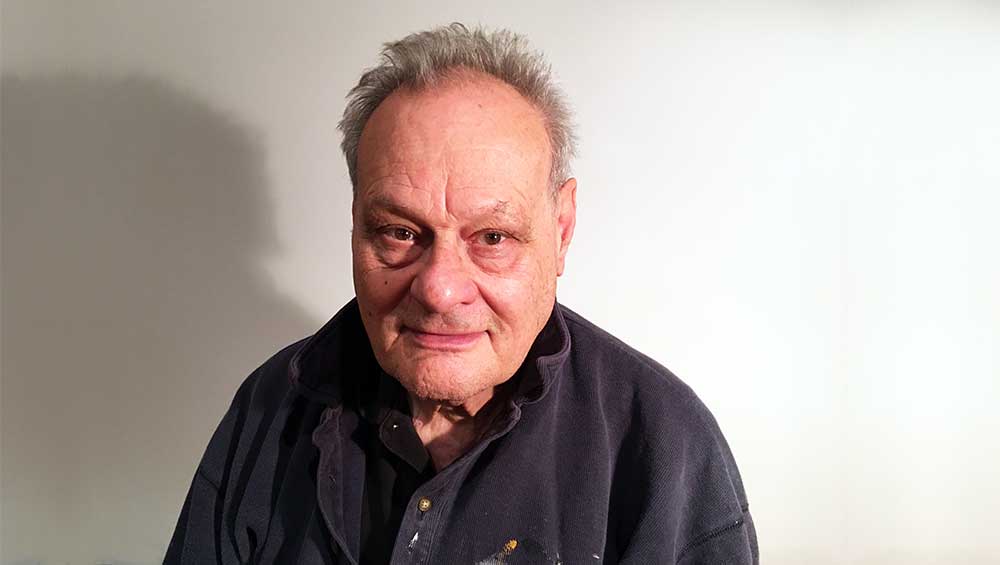
Mike Parr, 2023. © the artist.
by JANET McKENZIE
Drawing has increasingly become a structural and conceptual necessity for many artists working today. Infinitely more than the creation of an illusion, it is of psychological importance. The work of Mike Parr (b1945), one of Australia’s most significant artists, indicates the manner in which drawing has become an enabling activity. Drawing is an important way to incorporate reality into an overall scheme of things. Psychological space can be made to coexist with pictorial space, enabling a personal revision and leading to an expanded social and ethical role for the artist. Vulnerability co-exists with a radical cutting edge, where conceptual drawing can be united with a range of performance to illuminate psychic phenomena.
Parr says: “This cutting edge gives my performances acute intelligibility now because they ‘draw on the body’ not only to abreact psychic states but to inscribe resistances to the arbitrary nature of power. That’s the sense in which my performances become political for me, the sense in which they directly confront problems of representation, displacement and interpretation. I rejected painting early on because paint seemed like a cover-up to me. Performance art opened the way for me as an artist and I’ve remained extreme as a performance artist to this present day.”

Mike Parr. The Emertics (Primary Vomit) I am Sick of Art (Red, Yellow, Blue), Blue. Performed at Watters Gallery, Darlinghurst, Sydney, 1977. Photo: John Delacour.
In 1965, following two years of study towards an arts/law degree at the University of Queensland, Parr had a breakdown. He instinctively wanted to visualise the episode as a means of asserting order over turmoil. His father, who had himself had long periods of mental illness and trauma as an active soldier in New Guinea during the war, gave him a Funk & Wagnalls Standard Dictionary of the English Language as a 23rd birthday present, suggesting that he use it “to straighten out his mind”. Although linguistic or text projects occupied much of his earliest self-taught art practice, he also wrote poetry, but he gave it up once he learned to type. Typing was intended as a means to stop thinking and to begin seeing: “Seriality, texture, displacement and above all repetition, and a kind of Duchampian infra-mince. It was also a way of dealing with words and the meaning of formal solutions. I was very interested in the way patterns are confirmed and interrupted,” he says.
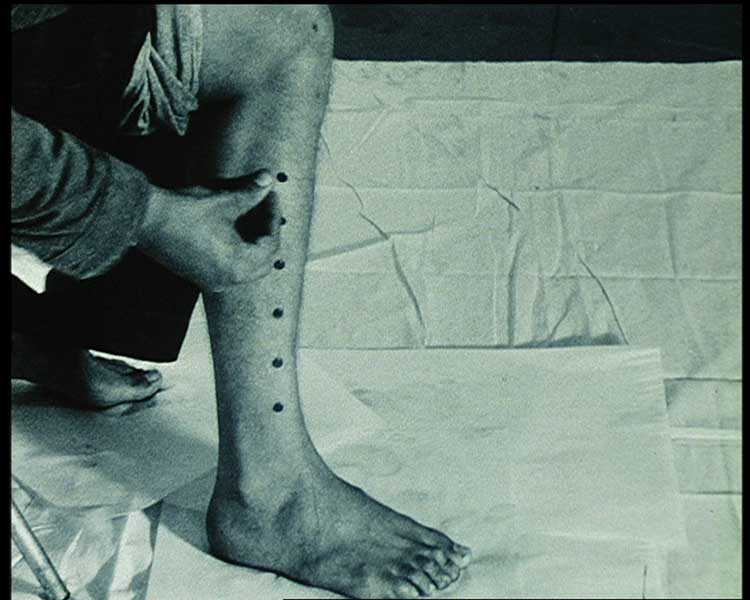
Mike Parr. Push tacks into your leg until a line of tacks is made up your leg (Wound by Measurement). Performed at Galerie Impact, Lausanne, Switzerland, 1973. 16mm film still.
Non-object art enabled Parr to channel mental extremes into behaviour with altruistic purpose and to transgress conventional boundaries as a matter of course. He describes the transition: “I was a performance artist with one arm. Straight away, the problem of visibility, the visual, was loaded completely differently for me. The traditional forms of art, venerated Australian artists such as Sidney Nolan, Arthur Boyd and Albert Tucker, were all in the way as far as I was concerned. ‘Father figures’ were always going to be an ambivalent inheritance. Controversial performances were accompanied by a massive sense of release right from the beginning. I’d discovered the power of acting out, but of course the problem of meaning remained, but that, for me, was, and is, essentially a cultural problem.”
Wall Definition, a text made in 1971, was conceived as a definition of the definition of every word in a definition of the word “wall” – it comprised a 254-page text. Parr is keen to point out that the Wall Definition project of 1971 led to the self-portraiture of the early 80s because they, too, parodied the very idea of identity through an endless process of re-representation. Through the 70s, visceral expression enabled an interrogation of self in highly charged durational performances. The process was a means to an end – to think. The study of law, which Parr has likened to a death sentence, precipitated what he is quick to point out was “breakdown then breakthrough”, an acceptance of himself as an outsider and a green light to be an artist. Vulnerability and psychic strength informed performances that often carried on for hours or days at a time; they made bold demands of the audience. The performance instructions from 150 Programmes & Investigations, 1971-72 are at once inspiring and amusing; a poetic call to arms, for a life of immense freedom:
Take up fighting.
Fight your fellow man.
Go out to fight every night of the week
for a couple of hours at a time.
Try to make the practice of fighting
a habit.
Fight everyone without discrimination.
I will destroy elements of my art for a fee.
Parr did not shrink from addressing pain and death in his performance, which can be interpreted as a form of catharsis, albeit a subconscious aspect of his art practice. After each performance, Parr says, his thought process enabled an adjusted mental and intellectual position, the next point of departure. The affirmative repetition of mark-making in charcoal continues to this day in staged legs of an indefatigable existential journey. The influence of Joseph Beuys (1921-86) has been seminal to conceptual drawing – explored in the 2014 Studio International publication The Drawn Word: Even if I write my name I am drawing (Beuys).
![Mike Parr. One of 12 Untitled Self-Portraits [Set 2], 1990. Drypoint and foul-biting from copper, printed in black ink on 350gsm Hahnemuehle paper, each print 107 x 78 cm. Printer: John Loane. Photo: Garry Sommerfeld. Collections of National Gallery of Australia, National Portrait Gallery.](/images/articles/p/028-parr-mike-2023/folder-04-4a.jpg)
Mike Parr. One of 12 Untitled Self-Portraits [Set 2], 1990. Drypoint and foul-biting from copper, printed in black ink on 350gsm Hahnemuehle paper, each print 107 x 78 cm. Printer: John Loane. Photo: Garry Sommerfeld. Collections of National Gallery of Australia, National Portrait Gallery.
Beuys’s crucial identification of the inner eye connected conceptual art and drawing and thus permitted him to assert the importance of the visionary role, and activism, over a finished product. A successful work for Beuys was determined by what has been experienced before the inception of the work. It was one that resonated beyond a physical manifestation, one that also captures the conception of and the creative process. For Beuys thought is form itself.
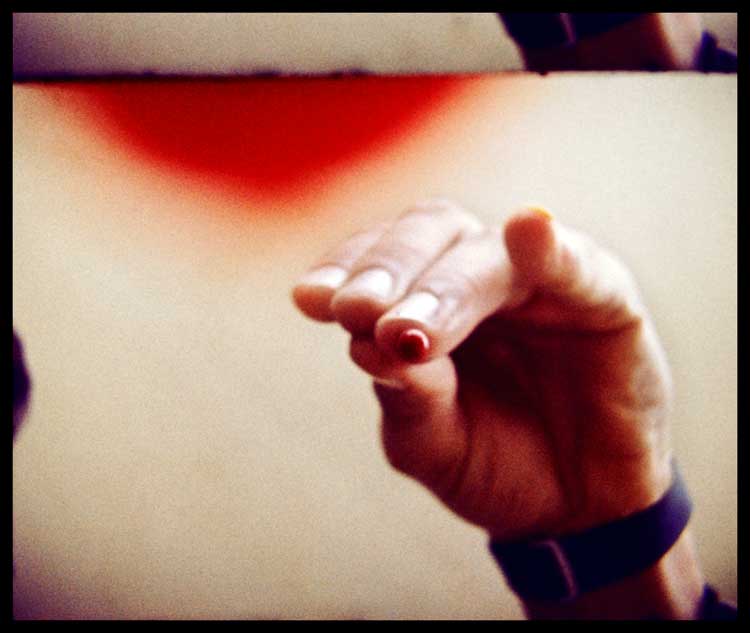
Mike Parr. Drip blood from your finger onto the lens of a camera, until the lens is filled with blood. Performed at Woolloomooloo, Sydney 1972. 16mm film still.
Photographs of the performances did not satisfy Parr’s febrile mind, so he took them as the basis of drawings. Self-portraiture was a natural extension where anger and torment were given powerful vent and he laboured over them with a poverty of technical means. Beuys, too, was an untrained draughtsman.
Parr says: “Beuys found freedom at the level of sensibility. It’s remarkable that he came to see his drawings as both marks of signification on scraps of paper and as objects that could be treated as depositions and that the act of dissociating his fragments could also become an act of sacramental release. Drawings, so separated from conventional depiction of the world and so separated from the history of drawing per se, are given back to the world as things in themselves, and this ‘gift giving’ is remarkable for its complete absence of ostentation.”
Parr’s drawing practice facilitated an avalanche of raw uncensored imagery in more than 1,000 self-portraits in 10 years.
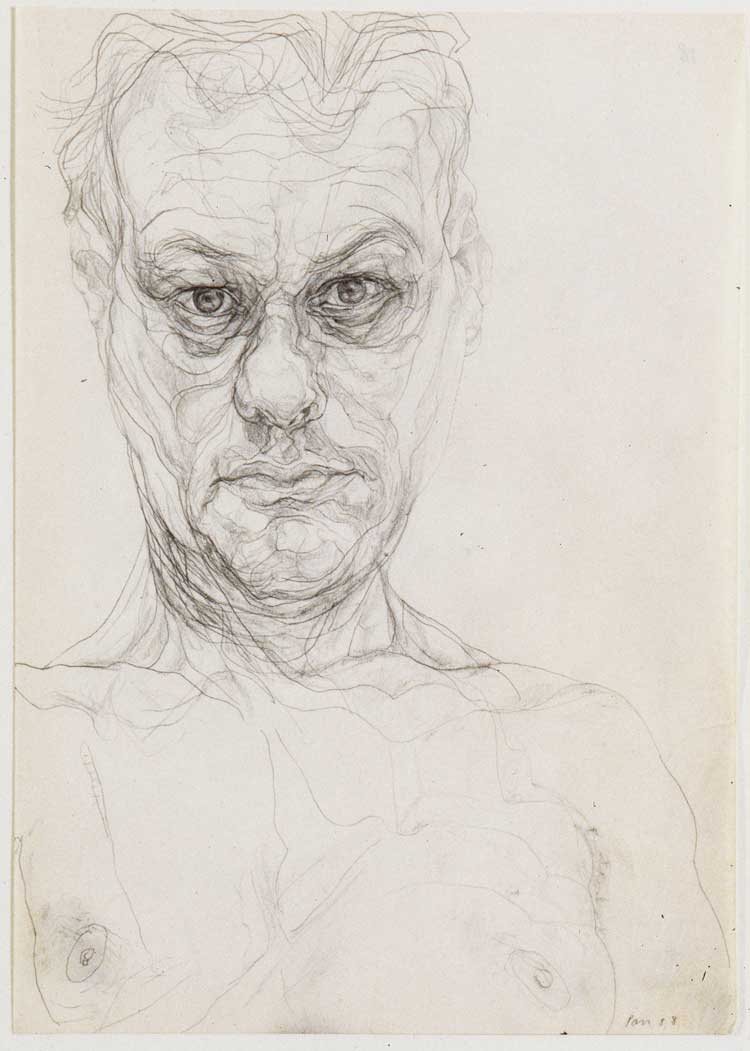
Mike Parr. One of 26 Untitled Self Portraits plus Portraits of F & C, 1981-96. Photo: Fenn Hinchcliffe. Pencil on typing paper.
The conceptual and the subjective, arguably the most vital components of contemporary art practice, connect in drawing more forcibly and more appropriately than in any other form of art. The broadest conceptual understanding of drawing, espoused by Beuys has been explored by numerous conceptual artists as they seek to think through the act of drawing.
For the 23rd Biennale of Sydney: Rīvus, 2022, Parr paid homage to Beuys – who, in 1982, proposed a plan to plant 7,000 oak trees in the German city of Kassel – by sleeping for three nights in a tree deep in the Blue Mountains, outside Sydney. The deliberate separation of this performance from the biennale was the point of the piece. In 1984, the 5th Biennale of Sydney, responding to Beuys’s original vision, had commissioned the planting of a single tree. A Moreton Bay fig was chosen in discussion with Beuys and planted in the grounds at the Art Gallery of New South Wales (AGNSW). Like all the 7,000 trees, the Sydney tree was accompanied by a basalt column. Four years later, the stone was removed without explanation, effectively “de-Beuysing” the tree. In 2006, in a half-hearted acknowledgement, the AGNSW and Performance Space commissioned Parr to redress Beuys’s marginalisation. Parr dressed himself as a bride and walked around the Beuys tree, meditated and fasted for three days and three nights, which he recalls as “days and nights of intense rain, wind and cold”. He says: “For some extraordinary reason, or for a reason as inscrutable as my own, on the last night of the performance a young man turned up with a shovel and began digging a trench towards me. His grave-like trench marked in my mind the missing basalt column. I changed the title of my performance; it became AMERIKA [the ice is melting].”
Parr created two works for last year’s biennale: Asleep in the Tree and the vast Blind Painting of a Falling Tree. Footage of the latter, taken by Gotaro Uematsu and Heath Franco, was installed as part of what Parr terms “the residue”. He explains: “Blind Painting of a Falling Tree was done as a public performance. The wall before the performance included two large screens built in. Paint from the performance dripped down the face of these screens and after the performance Uematsu and Franco’s video was installed to play through the lace work and drips of black paint. The residue, then, was everything left in situ after the performance.”
Asleep in the Tree and Blind Painting of a Falling Tree were both homages to Beuys and to his imposed “invisibility” in Australia, the first done in isolation, the second done blind. The 72-hour film of Asleep in the Tree was repeated on loop on a large screen at the AGNSW for six hours a day for 12 days. It forms a major work in Parr’s retrospective The Intimate Resistance: Mike Parr’s Performance Work 1971- 2023, which opens in June at the Bogotá Museum of Modern Art, and for an iteration of the same exhibition at Fondazione Morra in Naples that opens in September.
Parr says:
“Performance art, for me, is in advance – decisively in advance – because the event always exceeds the idea. I see something huge, black and impossibly uncertain. A body as trunk: a trunk as a body falling. Falling trees are everywhere: in Australia, in Indonesia, the Amazon, everywhere. Blind Painting is unprecedented because it acknowledges the history of art, so art is falling, too, beyond the trace, beyond the indexical, beyond mental reclamation. Must see the possibility of the unseen in this unseen way!”
I previously interviewed Parr in Australia in 2009 for the book Contemporary Australian Drawing (Palgrave Macmillan, 2012). In March 2022, I saw his work in Melbourne at the National Gallery of Victoria exhibition Who Are You: Australian Portraiture and at the 23rd Sydney Biennale.
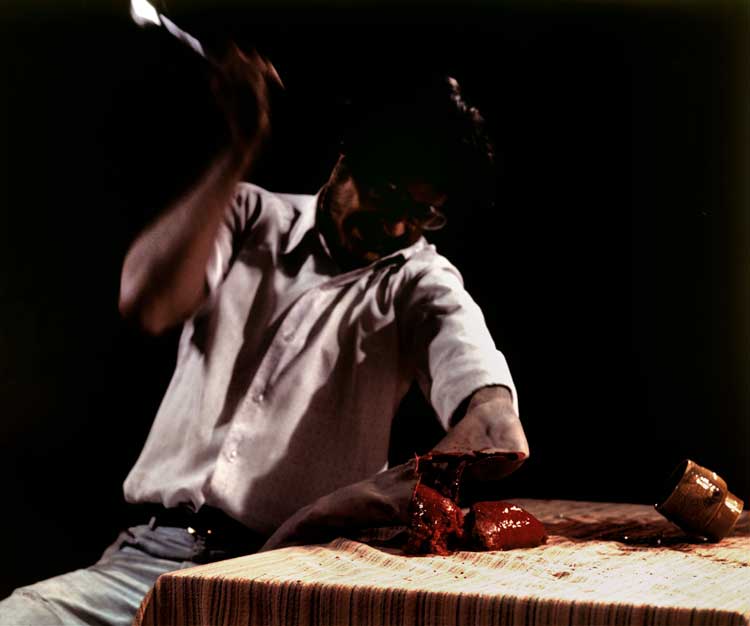
Mike Parr. Cathartic Action: Social Gestus no 5 (The Armchop). Performed at Sculpture Centre, The Rocks, Sydney, 1977. Photo: John Delacour.
Janet McKenzie: In 1984, you were chosen, with Imants Tillers and Ken Unsworth, to represent contemporary art from Australia in the US. An Australian Accent at the Museum of Modern Art in New York was a critical success for you all and a turning point in your career?
Mike Parr: It was one of the great moments of my life as an artist. It was also my first visit to America. The art I made for the exhibition was produced at breakneck speed in December 1983. The first 12 years of performance were coming to an end. I had become a famous Australian artist by holding my breath for as long as possible and hacking off a prosthesis attached to the stump of my left arm, but art as art was defeating me. I’d had no formal training as an artist, so I was learning on the job. This time I was working in the front room of a rented terrace house in Newtown, Sydney. The floor was trampled black with charcoal dust, and I’d pinned vast sheets of cut-down photographic backdrop paper directly to the walls. I was drawing giant self-portraits from failed performance photographs. The skid away from anxiety was turning into febrile and distant landscapes that opened out like idyllic, saturated bodies alongside the decapitated heads. This is literary talk now, but it was a life and death struggle then.
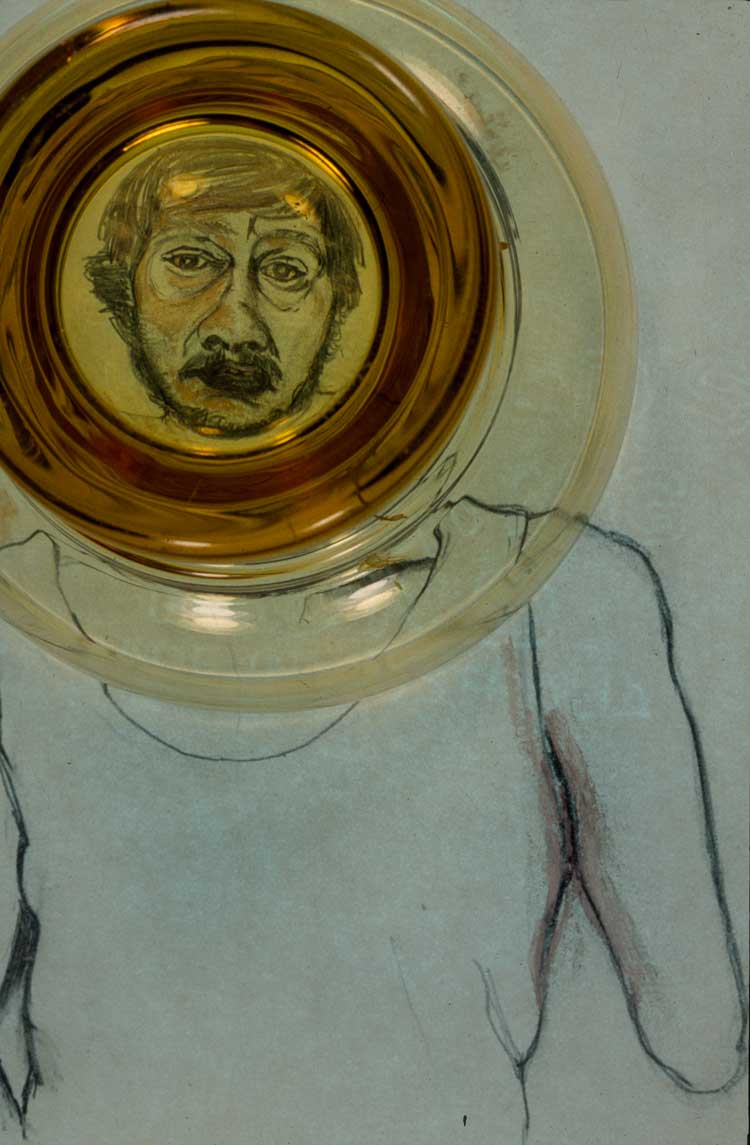
Mike Parr. Self Portraits through Mother’s Glassware, 1981-85. Cibachrome prints, size variable. Private collection.
JMcK: How do the conceptual and the subjective connect in your drawing practice?
MP: My latest drawing series has been going on for four years and will be shown later this year at the Anna Schwartz Gallery in Melbourne. It’s called Dirty Blanket. It’s currently continuing as an accumulation of about 150 boards (cheap 50 x 70cm presentation boards). I started this work in a state of absentmindedness, looking at and thinking about the one photograph I have of my brother Tim and me together. Tim died in 2009 after years of alcoholism and mental breakdown. I was his primary carer for the last 20 years of his life; he was one year younger than me. The boards are a quagmire of drawing with a constant return to this photograph. Tim had great difficulty in properly managing social relationships. The photograph was taken as we sat together at the wake following my father’s funeral. I am looking sideways and down. Tim is looking at me fixedly with a certain anxiety, confusion marked in his gaze. I feel he is trying to take his cue from my preoccupation in order to properly meet the world and this particular occasion.
![Mike Parr. Radio Daze (Minus 17 – Minus 53), 1998. 36 bronzes randomly distributed over 240 drawing boards (boards drawn both side)]. Board size: 51(h) x 76 cm (w) cm. Boards date 1981-98. Mixed media. Photo: QAGOMA. Collection of QAGOMA.](/images/articles/p/028-parr-mike-2023/folder-05-5b.jpg)
Mike Parr. Radio Daze (Minus 17 – Minus 53), 1998. 36 bronzes randomly distributed over 240 drawing boards (boards drawn both side)]. Board size: 51(h) x 76 cm (w) cm. Boards date 1981-98. Mixed media. Photo: QAGOMA. Collection of QAGOMA.
I’m working now with the intention of assembling the boards as a single installation. I’m still unsure about this resolution, because there is no end in sight, and I feel that what I’m looking for hasn’t been found. I know, of course, that I’m searching for “closure”, a resolution that is beyond representation, photography, portraiture, beyond the image as such. There’s a peculiar change occurring as the boards go on, because “likeness” is turning into abstraction and the ground is becoming increasingly thick, dirty, peculiarly coloured, but all of this is happening now as I continue to look at and work from the photograph with the mirror alongside and I am looking, “working” with the same void always in my mind. It’s called Dirty Blanket because I don’t bother to use fixative on my quagmire of media and because of a story told by [the English paediatrician] Donald Winnicott that particularly resonates for me, about his five-year-old daughter’s peculiar attachment to a dirty blanket.
JMcK: What is the significance of drawing on both sides of the presentation boards?
MP: What is really important is the realisation that if I do present all these boards as a unified area, I can hold back the other side. That finally I can go “public” while keeping one side private. I’ll rigorously preserve the chronology of the work’s production to do this. This is a kind of primitive defence, because the publicly precluded side will only ever be accessible to the work’s collector, but it’s also a way to preserve something of the intimacy of my relationship with Tim. We were inseparable. The boards that I am drawing now are simply the latest stage in a long line of boards over many years. Accumulations in the hundreds are broken off at a certain point and turned into a work.
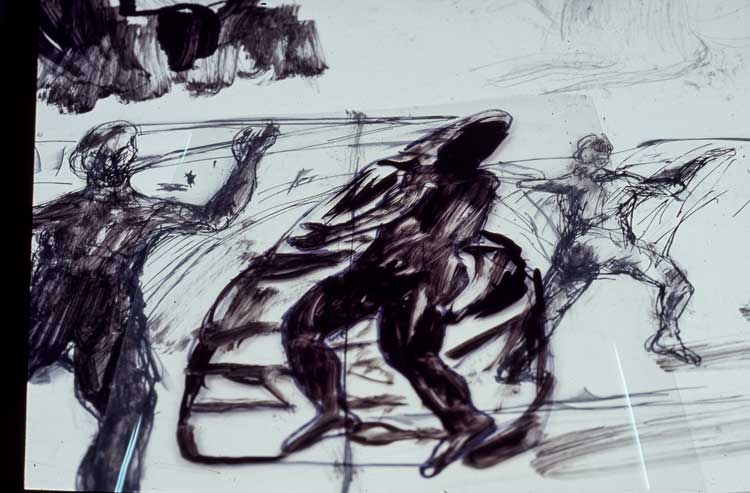
Mike Parr. The Side I Least Like, 1998-2017. One of 168 drawings (drawn both sides). Mixed media. Board size: 51(h) x 76(w) cm. Photo: Mike Parr. Collection: Art Gallery of NSW.
JMcK: Then there’s The Side I Least Like that sheds light on the gap between the making of the works and what happens to them when they enter a public space.
MP: In 2016, Stephanie Rosenthal invited me to exhibit in her Biennale of Sydney. She came by my ramshackle studio in inner Sydney. There was a heap of drawing boards on a workbench. She wanted to know what I would do with the work. I pointed out that all the boards were drawn on both sides. I said that I wanted to set them out as a huge, conjoined square on a gallery floor. Visitors would be free to take in the work by walking on the boards. I said that looking through the boards, there was always a side that I least liked. The Side I Least Like became the title for the work. Unfortunately, I’d already gifted the work to the AGNSW. It allowed the work to be lent to the biennale, but it became very disturbed by my exhibition plan. It wanted the work to be covered by a sheet of clear plastic and visitors were to take their shoes off. I laughed at the idea, and I doubt that the work will ever be exhibited by the AGNSW as I conceived it.
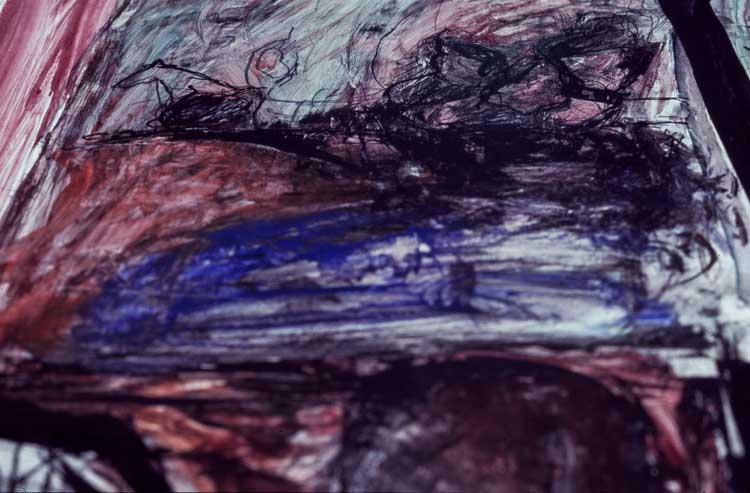
Mike Parr. The Side I Least Like, 1998-2017. One of 168 drawings (drawn both sides). Mixed media. Board size: 51(h) x 76(w) cm. Photo: Mike Parr. Collection: Art Gallery of NSW.
JMcK: Can you illustrate the link between a specific performance and a subsequent group of drawn images?
MP: One of my earliest performance instructions, from the 1971-72 collection 150 Programmes & Investigations, reads as follows: “Attack a wall with an axe. Hack into the wall. Do not stop hacking until you have broken through to the other side. [This piece subsequently informed the series of drawings The Other Side]. Then, in the mid-1980s, I did a number of anamorphically compressed, very thin, large self-portraits, austerely drawn with charcoal pencils. The images had all been mathematically plotted by me on laterally compressed grids, working from performance photographs, a rather beautiful, elusive image isolated to one side of a large sheet of paper. The title of the series is I Self-Portraits [Towards the Other Side], so the concept of “the other side” drifts through different states in all my work. I might also mention that the “I” of the title and the elongated form of the self-portrait are visually similar.
I’m answering your question about the conceptual and the subjective very episodically, but I’m also describing a familiar, recurrent pattern of transformation – of automatism becoming idea and idea becoming form and, in an instant, I’m looking back at my bookshelf and I’m seeing the spine of a book, Thinking as Form: The Drawings of Joseph Beuys (1993). Beuys’s drawings have been a touchstone for me. I am deeply moved by their origin, by their frailty and the tentative nature of their touch and the reluctance of his media. They hover in the ambience of a pantheism that is never objectified, approached always with extraordinary circumspection. A sense then of reluctance; of great, fragmentary psychic distance. I love the way that the drawing fragment is laid out sacramentally on the pure sheet of paper and the way we see collage at the end of a line, at the end of the modernist line of specified operations and procedures.
![Mike Parr. Femalias (12 Untitled Self-Portraits) Set 5, 1992. 12 prints to be installed 1 -6 [top], 7 – 12 [bottom] in an exploded grid, each 108 x 78 cm. Drypoint and liftground aquatint printed in black ink from 24 copper on 350gsm Hahnemuehle paper. Printer: John Loane. Private Collection.](/images/articles/p/028-parr-mike-2023/folder-11-Femalias_proof.jpg)
Mike Parr. Femalias (12 Untitled Self-Portraits) Set 5, 1992. 12 prints to be installed 1 -6 [top], 7 – 12 [bottom] in an exploded grid, each 108 x 78 cm. Drypoint and liftground aquatint printed in black ink from 24 copper on 350gsm Hahnemuehle paper. Printer: John Loane. Private Collection.
JMcK: Your self-portraits are in a state of flux?
MP: Yes, the self-portrait in my work has no stability. It’s infected by the grammatology of my writing. It bundles marks into variable, disjunctive syntax. The marks themselves inhabit the carapace of the image reluctantly or cathartically. Extreme torsions, tensions of contradiction but also a lot of invisibility, premonition, splitting. The other vital axis for my drawing in 1981 was my inability to draw, so teaching myself to draw became a deeply troubled aspect of the process of self-disclosure as drawing. I think this kind of turbulence is fundamental and it poses the same kind of struggle for both artist and teacher, because how does one attend to states that can’t be organised and theorised in advance of their appearance? I derive all my deepest insights of drawing as process from the process of involution and splitting, because “good” drawings become “bad” drawings” and “bad” drawings propel the process of reimagining and formal invention.
JMcK: 100 Breaths (1992) focuses the very potential of conceptual drawing; but there have been a number of repetitions and extensions via film since. In 1992, you drew 100 Self-Portraits on A4 sheets of copper and exhibited the 100 prints produced by breathing each sheet directly on to your face.
MP: A good lung capacity enabled me to hold each sheet of Hahnemühle paper over my face just by drawing in breath. One after another, in a continuous performance, the printed sheets were breathed on to my face. What’s particularly interesting is my increasing hyperventilation, because the glimpses of my face between the drawing masks become increasingly distorted as the performance goes on and the reciprocity between face and expressionist portrait is quite unexpected, peculiar and resonant. The soundtrack is simply the harsh inhalation/exhalation of breath, which also becomes more intense, laboured and extreme. The conceptual aspect of the drawings is to be found, I suppose, in the incommensurable but suggestive disjunction of their parts. 100 Breaths extends the implications of this disjointedness in a much more direct and challenging way.
![Mike Parr. Opic IIand, 1989. 12 prints to be installed 1 – 6 [top], 7 -12 [bottom] in an exploded grid, each 108 x 78 cm. Liftground aquatint printed in black ink from 12 copper sheets on 350gsm Hahnemuehle paper. Printer: John Loane. Collection: National Gallery Australia.](/images/articles/p/028-parr-mike-2023/folder-08-Opic-Iland-proof.jpg)
Mike Parr. Opic IIand, 1989. 12 prints to be installed 1 – 6 [top], 7 -12 [bottom] in an exploded grid, each 108 x 78 cm. Liftground aquatint printed in black ink from 12 copper sheets on 350gsm Hahnemuehle paper. Printer: John Loane. Collection: National Gallery Australia.
JMcK: Can you describe the relationship between your visceral performances in the 70s and your expressionistic drawing practice since the 80s in the context of Australian art?
MP: Expression in art and drawing, at least in the context of Australian art, is tainted by the suspicion that expressionism, pre-eminently a middle European form with a very long history going back to the Northern Renaissance, is essentially “Un-Australian”. This is in spite of the great work made in the 1930s and 1940s in Australia, of Danila Vassilieff, Tucker, the Boyds, particularly Arthur Boyd’s father, Merric Boyd, as a draughtsman, Joy Hester and Nolan, because displays of emotion and empathy don’t sit well with our inherited stiff upper lip. Inwardness was not a condition that afflicted the youthfulness and health of Australian culture. Indeed, Australian art, according to the conservative forces there, was filled with sunshine and amnesiac vitality and everything else in its off-colour ambiguity was to be held at bay.
![Mike Parr. The Lung (Subject / Object), 1991. 12 Untitled Self-Portraits (Set 4), 12 prints to be installed 1 – 6 [top], 7 – 12 [bottom] in an exploded grid, each 108 x 78 cm. Drypoint and liftground aquatint printed in black & deep green ink, from 12 copper and 12 steel plates on 350gsm Hahnemuehle paper. Printer: John Loane. Collections: Metropolitan Museum of Art, NY, Museum of Contemporary Art, Sydney.](/images/articles/p/028-parr-mike-2023/folder-10-The-Lung-proof.jpg)
Mike Parr. The Lung (Subject / Object), 1991. 12 Untitled Self-Portraits (Set 4), 12 prints to be installed 1 – 6 [top], 7 – 12 [bottom] in an exploded grid, each 108 x 78 cm. Drypoint and liftground aquatint printed in black & deep green ink, from 12 copper and 12 steel plates on 350gsm Hahnemuehle paper. Printer: John Loane. Collections: Metropolitan Museum of Art, NY, Museum of Contemporary Art, Sydney.
JMcK: In 2009, I drew a parallel with your work and the 70s Caged Painter works by Arthur Boyd (1920-99). At the time, in terms of the literature on your work, it seemed that expressionists and conceptual artists were unnatural bedfellows.
MP: In the 2016 catalogue for my National Gallery of Australia retrospective, Julie Ewington remarked on the “expressionistic” tendencies of my work, suggesting that both my performances and the drawings, and prints in the Self Portrait Project, “have consistently troubled both conservative critics and those aligned with post-conceptual art, for whom expressionism was seen as a retrogressive [step]”, asking: “Might it be considered un-Australian to deliberately surrender a male body to forces outside itself?”
JMcK: You have made a powerful connection between the intolerance and conservatism in the art world in 20th-century Australia and the racist imperial past rooted in the repressed British fear of emotional expression. Indeed, you have addressed this repression and hypocrisy in all your work for 50 years.
MP: This unanimity and convergence of conservative and so-called progressive forces to constitute a prohibition on thinking and feeling becomes, of course, the “blindness” of Australian culture. It is as though the unconscious of Australian culture has been split-off, because as a culture we are only permitted the surface of culture. Imitation, amnesia express our resolute, “unconscious” brutality towards all those desperate Others (refugees since the 1980s arriving by boat from Asia) coming towards us from the north, to this day.
JMcK: You have created and championed among the most challenging conceptual drawing in Australia.
MP: Cliched forms literally displace spontaneous feeling and new imaginative forms of drawing. My own drawing emerged as a consequence of my performance art. When people have asked: “Why are your performances so extreme? Why do you have to invoke limit states?”, I reply: “Because performance art enables me to think.” I mean by that, of course, that the thinking that precedes the performance is not the same as the thinking that follows it, nor are my feelings. It is the openness, the vulnerability and perhaps the paranoia induced by performance that I come to explore in the process of drawing, so I decided to try to draw something out of the photographic documentation of the performances that the performance record hadn’t taken account of, because even documentation provides an opportunity for self-concealment.
JMcK: Finally, can you explain the role of your inscrutable titles? There is no boat in Hades; Stiff Presbyterians; Minus Malevich; I’m dead, I’m dead, he said, he said; Mountains of Sand.
MP: These drawings all belong to the 2011 series of 35 very large drawings, which I called Cutting Tongues. When I think about it, Cutting Tongues is a highly appropriate title for a series of radically dismembered self-portraits. Many of the titles were found by browsing the dictionary that my father gave me in 1968. A kind of “see-saw of the either-or”. Irony and amusement explain my choice.
• The Intimate Resistance: Mike Parr’s Performance Work 1971-2023 opens on 29 June 2023 at the Bogotá Museum of Modern Art, and runs for three months. An iteration of the same exhibition will be shown at Fondazione Morra in Naples from 29 September 2023. The exhibition Dirty Blanket will be installed in three stages from 14 October – 16 December 2023 at the Anna Schwartz Gallery in Melbourne.